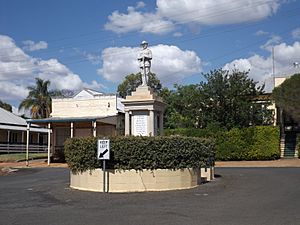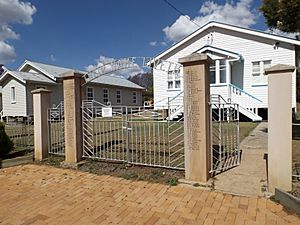Goombungee War Memorial facts for kids
Quick facts for kids Goombungee War Memorial |
|
|---|---|

War memorial in the centre of Kingsthorpe Haden Road, 2014
|
|
| Location | Hartwig Street, Goombungee, Toowoomba Region, Queensland, Australia |
| Design period | 1919 - 1930s (interwar period) |
| Built | 1920 - 1920 |
| Architect | Harry Marks |
| Official name: Goombungee War Memorial | |
| Type | state heritage (built) |
| Designated | 21 October 1992 |
| Reference no. | 600826 |
| Significant period | 1920- (social) 1920 (historical, fabric) |
| Significant components | memorial - plaque, memorial - soldier statue |
| Builders | R C Ziegler and Son |
| Lua error in Module:Location_map at line 420: attempt to index field 'wikibase' (a nil value). | |
The Goombungee War Memorial is a special monument located on Hartwig Street in Goombungee. This town is part of the Toowoomba Region in Queensland, Australia. It was built in 1920 by a company called R C Ziegler and Son. The memorial was designed by a well-known architect named Harry Marks. It is now listed on the Queensland Heritage Register, which means it's an important historical site.
Contents
A Look Back at the Memorial's Story
The Goombungee War Memorial was officially revealed on December 11, 1920. Important military leaders, Major General Sir Thomas William Glasgow and Brigadier-General James Campbell Robertson, were there. The memorial was designed by Henry James (Harry) Marks. It was built by R C Ziegler and Son, who were stonemasons from Toowoomba.
This stone memorial was created to honour the local men. These brave men from Goombungee had fought and died in the First World War and the Second World War.
In 1919, the people of Goombungee wanted advice for their planned memorial. They asked the Queensland Institute of Architects for help. Harry Marks, an architect from Toowoomba, then created the design.
Harry Marks was born in Toowoomba in 1871. He learned his skills from his father, who was also an architect. Harry was known for his creative designs. He designed many buildings in the Darling Downs area. He also designed two Roman Catholic Churches in Brisbane. Harry Marks spent his whole career in Toowoomba. He passed away there in 1939. This memorial is a unique example of his work.
The monument was made by R C Ziegler and Son. They were a well-known company in Toowoomba. However, the statue of the soldier, often called a "digger," was likely brought in from Italy.
The company R C Ziegler and Son started in Toowoomba around 1902. They made many memorials across south-western Queensland. The family business later moved to Bundaberg. It was still working there in 2014.
Why War Memorials Are Important
Before the First World War, Australia didn't have many public monuments. The memorials built after this war became our first national monuments. They showed the huge impact the war had on our young country. Australia lost about 60,000 soldiers. This was out of a population of about 4 million people. It meant one in five of those who served died. No other war has affected Australia so much.
Even before the war ended, memorials became a way to show national sadness. For the people who built them, these memorials were like sacred graves. They were substitute graves for Australians whose bodies stayed in battlefields overseas. The British rule was that soldiers should be buried where they fell. The word "cenotaph" means "empty tomb." This word was often used for war memorials.
Australian war memorials are special because they don't just remember the dead. Australians were proud that their first big army was made only of volunteers. These men were worthy of honour, whether they died or not. Many memorials honour everyone from a local area who served. This includes those who died and those who returned home. They provide important information about how communities were involved in the war.
Australian war memorials also show our loyalty to the British Empire and our own nation. At the time, these loyalties were not seen as being in conflict. They also show the skills of local stonemasons, metalworkers, and architects. And they reflect the popular tastes of the time. In Queensland, the "digger" statue was a very popular choice for memorials. In southern states, tall, thin monuments called obelisks were more common.
Many First World War monuments have been updated. They now include names from later conflicts. Some have also been moved or repaired in ways that weren't very careful.
The digger statue is the most common type of memorial in Queensland. Communities chose it most often. It represents the ANZAC Spirit and the qualities of the ideal Australian. These qualities include loyalty, courage, youth, innocence, and masculinity. The digger statue was unique to Queensland. This might be because other states had groups of architects and artists who advised on memorial designs.
Most digger statues were made by local stonemason companies. However, some were made by artists or brought in from other countries.
What the Memorial Looks Like

The First World War Memorial stands where the two main streets in Goombungee meet.
The memorial is made of painted sandstone. It has a base, called a pedestal, with a digger statue on top.
It sits on a large square base of smooth stone. From this base, a square section sticks out. It has marble plates on each side. These plates list the names of 29 local men who died in the First World War. They also list 8 men who died in the Second World War.
Also sticking out from the base, at each corner, are free-standing columns. These columns have special tops called Doric capitals and bases. They hold up a large cornice. This cornice is made of several steps and decorative mouldings.
The digger statue stands above this on a base with three steps. These steps are square and get smaller as they go up. The soldier's head is bowed. His hands rest on the top of a rifle, which is held upside down.
Why It's a Heritage Site
The Goombungee War Memorial was added to the Queensland Heritage Register on October 21, 1992. It met several important rules to be listed.
It shows how Queensland's history has changed. War memorials show a common part of Queensland's history. They represent a time when many communities across the state were very patriotic. This was especially true during and after the First World War.
It shows the main features of this type of historical place. These monuments are a unique historical record. They also show what was popular in design between the two World Wars. The Goombungee memorial was revealed in 1920. It shows the main features of a monument built to remember a big historical event. It uses the right materials and design. As a digger statue, it's a great example of the most popular type of memorial in Queensland.
It is beautiful and well-designed. This memorial is important because it's a strong landmark. It also shows high-quality work and design.
It has a strong connection to the community. The memorial has a strong link with the Goombungee community. It shows how a major historical event affected them.
It is connected to important people in Queensland's history. It also has a special connection to the Toowoomba architect H J Marks. It's an unusual example of his work. It also connects to the stonemason company R C Ziegler and Son.

